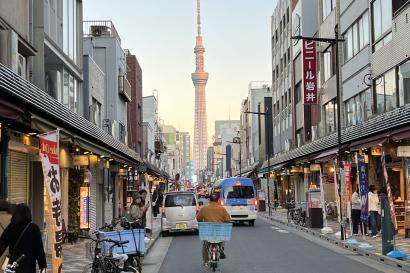
When I first heard about the Social Organization of Japan: Field Placement class that IES Abroad was offering, I decided to apply in order to gain valuable insight into the work culture of Japan and get to practice my Japanese more. I ended up being placed at the Institute for Sustainable Energy Policies (ISEP), an independent, non-profit research organization that was founded in 2000. There, energy experts and climate change campaigners alike, work to provide resources and services to promote sustainable energy policies in Japan and abroad (Europe, U.S, and other Asian countries) by promoting renewable energy, improving energy efficiency, and restructuring the energy market.
At first, I was really nervous about working at ISEP. I didn’t know how I would overcome the language barrier. I worried I would be useless. I worried that I wouldn’t make friends. I worried that I wouldn’t understand or be able to assimilate into the workplace culture. I worried that it was a mistake to have applied for the field placement class. But now, as my final day nears, everything has become second nature to me. I am used to my hour long commute by train to Nakano Station. The walk to the office only takes me about 8 minutes, 10, if I stop to buy oranamin C and an onigiri for breakfast, and my permanent spot is in the middle of the table, next to Yamashita-san.
One of the things that caught me off-guard, was that that there were no cubicles in the office. Everyone on the research team worked in the same room, all situated comfortably along a long wooden conference table. At first, I did feel extremely vulnerable, exposed amidst my Japanese coworkers. I was sure that my tension and anxiety were palpable. I was so used to asking questions in private, and to have to speak directly to my supervisor while sitting amongst colleagues was incredibly daunting and embarrassing. It confused and perplexed me to be privy to every phone call and conversation, and to be in such close proximity to my supervisor. At first, it felt as if I was being constantly monitored, my ineptitude on full display.
In American work culture, it is pretty standard to work unilaterally on a long-term project, secluded in your personal cubicle. When I interned at Washington, D.C, sometimes I went weeks without seeing my supervisor because she was away on business. I guess I was just used to having more independence in the working place. But, in retrospect, I shouldn’t have expected the Japanese work-place to conform to my vision of an American work-place. It’s so easy to apply your idea of “normal” to everyday experiences living abroad, and forget that you’re a foreigner—a guest in a country with its own separate and equally valid cultural norms.
After reading “Chapter 5: In Place,” for my IES Abroad seminar class, I came to understand the various merits of a communal workspace. Firstly, it makes it easier to ask questions. The article expands on this idea of, “If I am having trouble with something, usually someone will notice and come to offer help—without my having to ask (In Place, 60).” When you are at the shima (conference table), it’s easy to make eye-contact with a senior or another intern sitting across from you, and then ask them for help. I’ve found that asking questions in this formation also helps to facilitate discussion. There have been times where I ask Yamashita-san (my supervisor) for clarification on an article, and T-san or K-san (fellow interns) will jump in to discuss the implications of the paper as well.
Secondly, having a seat at the shima also made me feel like “I was joining their team rather than ‘going to work (In Place, 60).’” I’ve found that this seating arrangement created a perfect segue to better understanding the workplace culture, and engage in informal learning. From my vantage point, I was able to learn through “observation and trial and error,” rather than direct instruction (On-the-Job Learning, 84). This allowed me to understand social cues, nonverbal communication techniques, and how “to be able to sense the mood (kūki) (On-the-Job Learning, 57).”
I am so grateful I was accepted into the Field Placement program—although I know that my success was only made possible because of the generosity and welcoming spirit of ISEP. I not only learned a lot about Japanese work culture, but also the tangible knowledge that comes with working at an internationally recognized renewable energy NPO. In the end, I was able to find my place amongst my colleagues. It was rewarding to finally figure out how I could help support ISEP’s mission through my own initiative, whether it was by using my graphic design skills, proofreading, or transcribing interviews in English. I truly felt like a part of the team.

Emily Okikawa
<div>Emi Okikawa escaped from Oahu, Hawaii by hiding in the cargo hull of a plane headed for the East Coast. </div>
<div>She was last seen at Franklin & Marshall College in Lancaster, PA.</div>
<div>Recent rumors have surfaced about her being set loose in Tokyo. Be advised, the suspect has been spotted eating her weight in Japanese pastries and sitting in animal cafés for multiple hours a day.</div>








